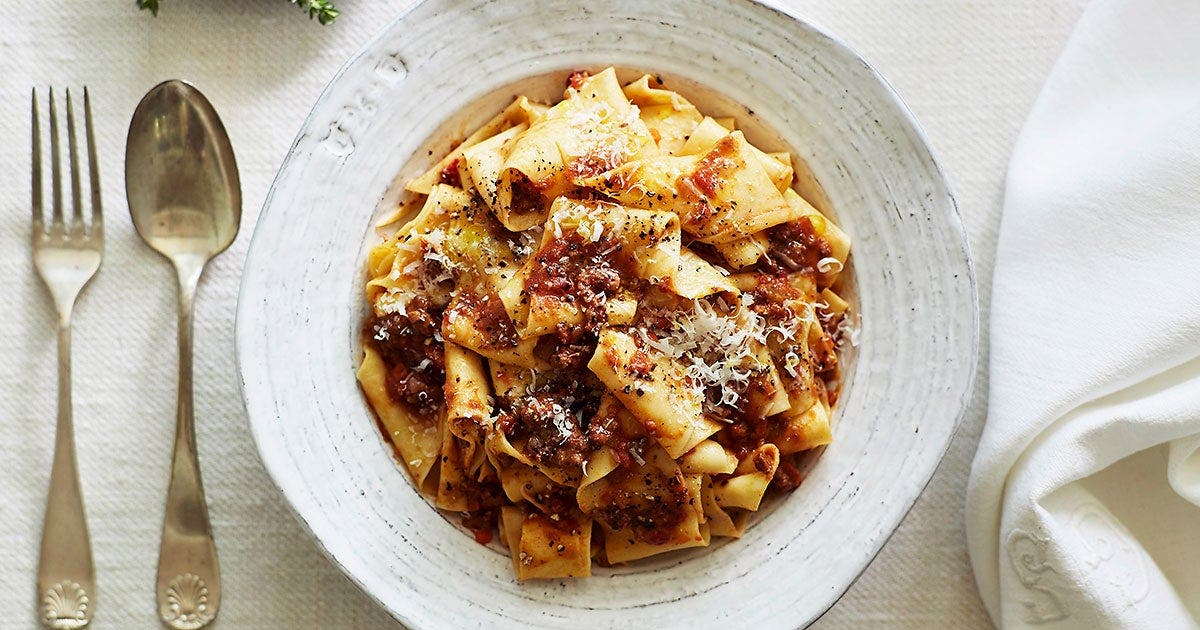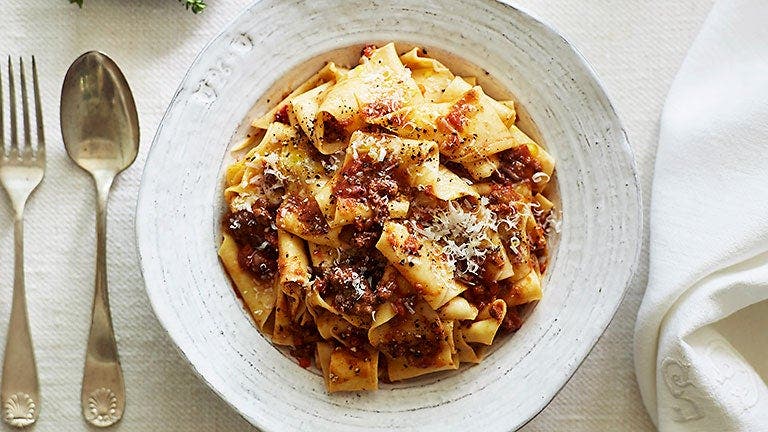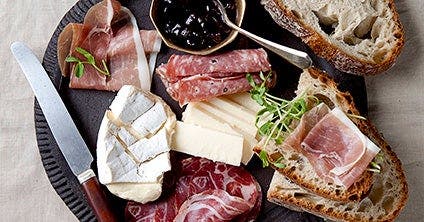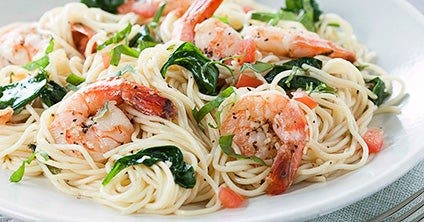Everything You Need to Know About Eating Italian Food on WeightWatchers®


What to Know:
Bread & Antipasto 
Use oil, not butter
Not only is olive oil a source of healthful monounsaturated fat, but a Cornell University study found that diners who used olive oil as a bread condiment ate 23 percent less bread than those who used butter. Just don’t soak the bread entirely; one dip is enough.
Don’t O.D. on lunchmeat
A common meat antipasto is misto salumi, or Italian charcuterie that includes dried meats like the familiar prosciutto. While these meats are high in fat they usually come in very thin slices. A thin slice can be satisfying because it’s intense in flavor, but the key is to not make a sandwich with it...
Consider going tapas
It’s perfectly fine to make a tasting meal of antipasti. You can pick one indulgence, like risotto balls, and balance it with a number of healthier selections.
Don’t overlook soup
Soup is a main course in authentic Italian restaurants but you can also order it as an appetizer. Traditional Tuscan and Florentine soups, with combinations of escarole, beans, pasta and sausage, can be good alternatives to meat antipasti or salads filled with cheese.
Pasta or main course
Have your penne with protein
If it’s an option, pay to add chicken or shrimp to your pastaEven though you’re adding something ,you’ll eat less food overall with one course. And that single plate will be more filling and satisfying than pasta alone.
Go halves on pasta
Often, it’s not the pasta itself, but the portion that is most destructive to a healthy diet. You can order a half portion, or order two different half portions, and split the difference between a splurge and a healthier choice.
Fill your plate with air
A hollow pasta, like ziti, orecchiette, bucatini, etc., will appear to give you a larger portion size than solid pasta, like spaghetti or fettuccine. And that may help you eat less of it while still feeling satisfied. The opposite is true of risotto. “White pasta and white rice are nutritionally similar, but rice is much denser so you’re likely to eat a larger portion of risotto than of a lighter, hollow pasta.
Be stingy with the cheese
An ounce of Parmesan cheese adds 4 Points. If you want some, ask the waiter to grind a bit onto your pasta — or sprinkle it on yourself and then get that cheese off your table. Otherwise, you’ll be tempted to keep spooning on more cheese throughout your meal.
Understand gluten-free pasta
You’ll see this on more menus now, but don’t think that gluten-free pasta is healthier or lower in calories than white or whole-wheat pasta. Gluten-free foods were developed for people who have gluten intolerance (or Celiac Disease) and exclude wheat, barley, oats and rye. Unless you can’t tolerate gluten, there’s no benefit to ordering this pasta.
What to Eat:
The tips below will let you lighten up your favorite dishes while keeping them hearty and tasty. Here’s to relishing real Italian, while toasting “Salute” — to health!
 | Caprese Salad Lighten it up: If you’re going to have cheese with your entrée, consider having a peppery arugula salad with balsamic vinegar and tomatoes (0 Points) to start. |
 | Fritto Misto Lighten it up: If you crave a nibble, order this as a shared appetizer, and dip in with marinara instead of aioli. Better yet, order grilled calamari as an app (0 Points per half cup). |
 | Pappardelle Bolognese Lighten it up: Switch to pasta with marinara sauce and order a small piece of chicken, pork or veal with it. And consider ordering whole-wheat pasta when available; it has more fiber and will save you 1 Points per cup (5 versus 6). |
 | Tortelloni alla Ricotta Lighten it up: Avoid Alfredo and pesto sauce; marinara is a lighter choice. Or consider asking for broth instead ("en brodo"). You’ll have a delicious, authentic dish and could save 3 Points over the marinara. |
 | Risotto with Mushrooms Lighten it up: Order risotto with olive oil and just a pat of butter; it can trim off 3 Points. Mushrooms are a great choice for flavoring, as are traditional additions of seafood, squash, peas and saffron. Going with pancetta will add 4 Points. |
 | Polletto alla Diavola Lighten it up: Removing the skin and getting your sauce on the side may knock it down to about 15 Points. |
 | Cotoletta alla Milanese Lighten it up: Instead of Milanese, ask the kitchen to grill a veal chop or chicken breast with some herbs. A typical boneless veal chop (about 3 oz before cooking) runs about 6 Points. |
 | Branzino Lighten it up: Some restaurants go heavy on oil and butter, so ask for yours on the side. And consider replacing the side of pasta with a vegetable. |
 | Tiramisu Lighten it up: Get one for the table to share. |
Fresh Strawberries with Balsamic Vinegar *Given that ingredients, cooking methods, and portion sizes can vary greatly among restaurants, all Points values for restaurant dishes are estimates. |
Italian 101
It’s All Gravy
While there are many varieties of pasta sauce, they fall into these main categories:
Tomato/marinara
About 3 Points per half cup
Simple tomato sauce (known as salsa al pomodoro in southern Italy, or marinara in the United States) is usually the best choice. Adding meat (making it a Bolognese), fish or cheese can double the Points.
Vodka sauce
About 5 Points per half cup
This is really just marinara sauce with heavy cream, butter and vodka, but people think of it as its own variety.
Alfredo
About 14 Points per half cup
Made with heavy cream, butter and Parmesan cheese, the nefarious Alfredo sauce is your worst choice If you love Alfredo sauce, try to balance the fat by choosing a dish with vegetables or protein, like pasta primavera with chicken.
Olive oil-based sauces
About 7 Points per half cup
Unlike Alfredo, most “white” sauces that aren’t made with cheese use olive oil as the base and then cut it with white wine or broth. A teaspoon of olive oil has about 1 Point (a half-cup has 33); a simple “oil and garlic” pasta dish may be slicked with about one-third a cup of oil. A typical white clam sauce can run 5 to 7 Points per half cup.
Pesto sauce
About 19 Points per half cup
This Northern Italian sauce is made with olive oil, pine nuts, garlic, basil and Parmesan cheese. While it can be highly fattening, the strong flavor will let you use much less of it than you would marinara sauce. You might drizzle 4 tablespoons (for 9 Points) on a dish of pasta.
Menu Decoder Al Dente: It literally means “to the teeth,” but this term means you want your pasta firm in the center (not overcooked). “There’s no need to ask for this — you can assume it will be cooked this way in a quality Italian restaurant,” says Brandwein.
Arrabbiata: An “angry” (spicy) red tomato sauce from the region around Rome. Red chilies kick up the heat. A good choice.
Arrosto: Roasted.
Burrata: A trendy, decadent cheese from Puglia that’s filled with cream.
Caponata: Italy’s answer to ratatouille, this Sicilian dish of eggplant, garlic, peppers and other vegetables is served as an appetizer or as a companion to fish or bread.
Carbonara: A hearty meal of pasta in bacon or pork fat, with eggs and cheese. It can pack 16 Points per cup.
Crudo: Literally “raw,” crudo on Italian menus refers to raw fish in citrus and oil. Think ceviche.
Fra diavolo: A term meaning “brother devil” usually means a dish has red sauce spiked with red pepper or cayenne.
Fresh pasta: Unlike dried pasta, fresh pasta is soft before cooking and includes a large number of egg yolks. It’s most popular for stuffed and shaped pastas that are made onsite.
Fritto: Fried.
Gnocchi: These Italian dumplings are made with potato or, sometimes, cheese. One cup of potato gnocchi has 7 Points per cup; cheese kicks it up to 17.
Mozzarella di bufala — Cheese made from the milk of domestic water buffalo is higher in protein, fat and minerals than cow’s milk mozzarella, and has about 4 Points per ounce.
Polenta: A creamy porridge made of ground cornmeal. "Be aware it may be loaded with cheese or cream," says Dobbins. Plain Polenta has about 7 Points per cup.
Zabaglione: An egg, liquor and sugar sauce that often dresses desserts or fruit. It packs about 7 Points per half cup.
